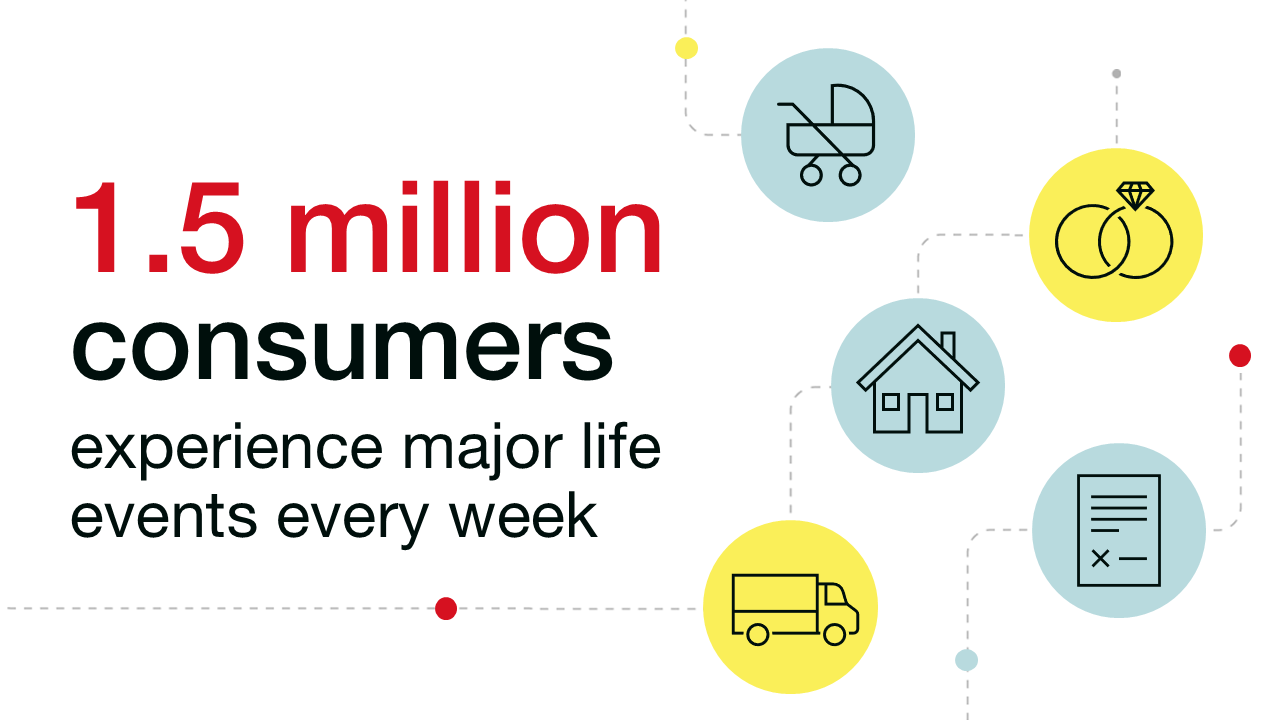Life is full of important financial decisions, often spurred on by major life events. For the average consumer, this includes moments like getting married, expecting a child, preparing for a move, moving residences or selling a house. The same can be said of business owners experiencing milestones like starting a new business, relocating their company or expanding their operations.
Of the financial decision-makers that make up these groups (specifically lifestyle, household and business owner categories), it’s estimated that 1.5 million consumers experience major life events each week, and approximately one million businesses reach an important milestone every month, all of which can trigger unique financial and purchasing decisions.

Known as trigger events, these pivotal moments open the door for businesses to connect with consumers and businesses on the verge of making important financial buying decisions. These timely events create opportunities to build new relationships or expand existing ones by connecting with consumers and businesses when change is already on their mind. As such, marketers can use triggers to capitalize on these transitions to achieve more successful results.
What is a trigger marketing campaign?
A trigger marketing campaign is a type of marketing strategy that automatically delivers messages or offers to customers based on specific events or conditions, i.e., triggers. In short, this strategy is about sending the right message to the right audience at the right time.
Why movers are a prime trigger marketing audience
While all triggering events are impactful in their own way, mover trigger campaigns reach people during one of the biggest events of their lives, an event that happens repeatedly to a large percentage of consumers. With approximately 25 million Americans relocating in the last year alone, new movers represent a valuable target market as they are likely to engage with new brands and make substantial purchases within a predictable timeframe.

Here's an example: Consider a homeowner listing her property for sale. She’s interested in fixing up her home to drive a better listing price. In preparation, she’s researching roofers, painters or electricians to hire. Additionally, she’s most likely securing financing or obtaining a new mortgage to purchase her next home. Once her home sells, she’ll have to purchase moving supplies and household items for her new residence. It’s been reported that existing homebuyers spend more than double on furnishings in their first year after moving versus non-moving homeowners, with first-time home buyers spending even more. If she’s moving to a new city or state, she might even be searching for healthcare professionals, service providers retailers and more.
Moving is a hectic time, and trigger marketing campaigns can provide consumers with relevant offers while these needed goods and services are top of mind. It’s a win-win for everyone, as consumers are served with relevant offers while marketers can achieve a greater return on their marketing investment.
Key elements for successful trigger marketing
Effective trigger marketing relies on comprehensive data and speedy delivery. This powerful combination works hand-in-hand to help drive effectiveness and ensure meaningful results.
1. Comprehensive data coverage increases response rate
While mover data is critical, relying on a single source isn’t enough. Different data sources can report a mover trigger at varying times, and if a company depends solely on one source, it risks launching its outreach too late. Aggregated data, i.e., data that’s been culled from various sources, allows competitors to engage with consumers in a manner that’s more time sensitive.
This was certainly the case for one global communications company with a dedication to delivering internet services to underserved rural communities.
With the goal of lowering their customer acquisition costs, they leveraged dozens of aggregated specialty trigger databases on a weekly basis, identifying four times more targets than if they were working with only one provider. The company used these insights to test more than nine top new-mover data providers with a strategic direct mail pilot program.
The results easily and quickly proved the need for data aggregation. The initial campaign achieved a 27 percent increase in gross response rate and a threefold increase in net response.
2. Speed to market boosts revenue potential
To dominate the competition in the fast-paced world of mover targeting, baseline campaign elements must be vetted and ready to deploy if marketers want to increase the likelihood of their campaign’s success.
The first step is identifying the most effective marketing channels for use, e.g., direct mail, email or digital outreach. Given the chaotic nature of the moving journey, targeting multiple channels may prove most effective. Marketers should also consider that compelling messaging and relevant offers are prerequisites for converting movers into loyal customers. When aligned correctly, both can position a brand as a trusted ally during significant life changes. Once all marketing elements are ready for deployment, the second step is ensuring marketers can process and use mover data to get a campaign off the ground quickly.
One prominent national home furnishings brand recognized the urgency of connecting with movers immediately to gain a competitive edge and grow revenue. Through a pilot campaign, they found that mover data that was four to five weeks old produced a response rate of only 1.82 percent, whereas data that was only a week old achieved an impressive 4.47 percent. This strategic shift in timely outreach resulted in a 145 percent increase in response rates and an incremental rise in average order values.
Measuring success: The devil's in the details
The old adage rings true: "What gets measured gets managed." Measuring the success of trigger marketing campaigns helps fine-tune strategies and amplifies their effectiveness in the future. Here are a few metrics to monitor:
- Conversion rate analysis: For stronger marketing optimization, it’s important that marketers understand the full scope of how many consumers actually converted after receiving the marketing. This isn’t always easy. Attribution needs to have a well-rounded, thoughtful approach to uncover all the conversions, not just those who may have used a promotional or QR code to purchase. This data is vital to unlocking the full marketing potential of a trigger campaign.
- Cost per acquisition evaluation: If marketers analyze the cost of acquiring a new customer through trigger marketing compared to other efforts, it ensures investments are focused on the right marketing channels and tactics to maximize sales.
- Revenue/profit analysis: Return on Ad Spend (ROAS) is a powerful metric that reveals the revenue generated for every campaign dollar spent. Monitoring this profit indicator enables marketers to make better long-term decisions about a campaign’s creative direction, spending and timeline.
The bottom line
Mover trigger campaigns offer unique, powerful opportunities for marketers to connect with consumers during critical moments in their lives. Movers represent an invaluable target market with an increased likelihood of engaging with new brands and making substantial purchases. Through smart mover trigger campaigns, marketers can effectively reach consumers at the right moment, helping foster long-term loyalty, driving significant business growth and maximizing return on their marketing investment.
New Mover Triggers
Reaching movers is easier than ever with superior marketing data from Deluxe.
RECOMMENDED RESOURCES




